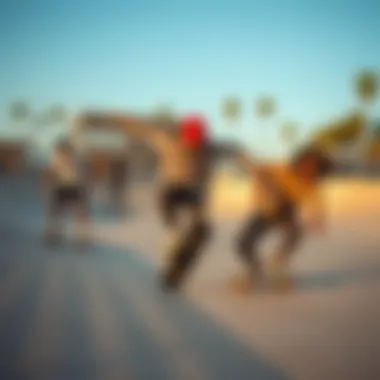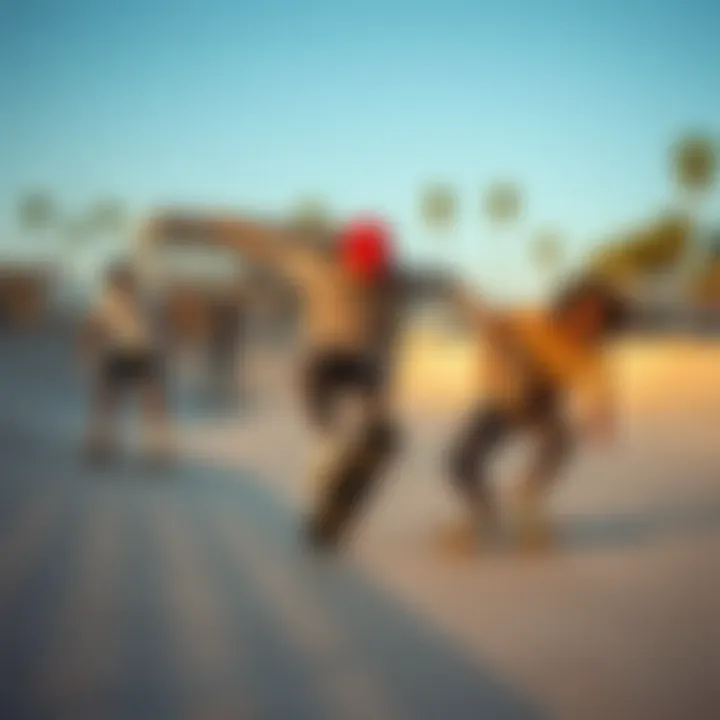Explore the Best Skateparks in California


Intro
California, with its perpetual sunshine and laid-back vibe, has long risen to fame as a mecca for skateboarders. Each skatepark here serves as a chapter in the collective story of skate culture, flourishing in the streets and pushing the limits of creativity and athleticism. From San Francisco’s iconic hills to Los Angeles’ polished parks, these locations don’t just cater to the community; they encapsulate a way of life.
Skateparks across the state present a unique blend of features tailored to tone down the barriers between seasoned professionals and eager novices. The vibrant atmosphere is often infused with local culture, making each park a microcosm of California's diverse skateboarding landscape. In this piece, we’ll explore what separates these skateparks from the pack—be it their state-of-the-art designs, accessibility, or the cultural milieu that surrounds them.
Skateboarding Techniques
Skateboarding is not just about riding a board; it’s about mastering a blend of techniques that vary from simple foot placements to complex aerial tricks. Each park could potentially be a training ground as well as a creative canvas.
Essential Tricks for Beginners
Beginning skaters often grapple with the fundamentals. Here are some essential tricks that can lay a solid foundation:
- Ollie: The cornerstone of many tricks. The ollie involves popping the tail of the skateboard while dragging the front foot up.
- Kickflip: A step up from the ollie, this trick entails flipping the board by dragging the front foot on the edge while jumping.
- Shuvit: This maneuver involves spinning the board 180 degrees while keeping your feet planted. It’s one of the first entries into more complex trickery.
Understanding these basics not only builds confidence but also unlocks a variety of advanced maneuvers.
Advanced Maneuvers for Experienced Skaters
For those who have mastered their balance and coordination, the following tricks can elevate their skating to another level:
- Heelflip: Similar to a kickflip but involves kicking outwards with the heel, creating a different board spin.
- 360 Flip: A combination of a kickflip and a shuvit, resulting in a complete rotation of the skateboard while flipping.
- Smith Grind: This trick requires some finesse with grinds, where the back truck grinds on an edge while the front truck hangs over.
The capacity of a skater to pull these off often stems from practice and familiarity with their local park’s features. Mastering these techniques allows skaters to creatively express themselves, contributing further to the skate culture in California.
Gear and Equipment Reviews
Having the right gear is crucial for your skating experience. Let's take a closer look at essential skateboard setups and safety.
Top Skateboards for Every Skill Level
Whether you’re just getting your feet wet or an experienced skater, selecting the right board matters:
- Element Skateboards: Known for both durability and design, suitable for beginners and intermediate skaters.
- Santa Cruz Skateboards: A classic choice, appreciated for their solid construction and aesthetic appeal—great for all skill levels.
- Baker Skateboards: Favored by many pro skaters, they balance performance and wheel quality, suitable for seasoned enthusiasts.
A skateboard can greatly affect how tricks feel and perform, making it imperative to choose one that aligns with your style.
Protective Gear: Importance and Recommendations
Going for a ride without protection can be risky, especially in bustling parks. Here’s what you should not overlook:
- Helmet: A non-negotiable piece, it shields the head in case of falls. Brands like Triple Eight and Pro-Tec offer reliable options.
- Knee and Elbow Pads: These can help prevent injuries from tumbles, aiding recovery and encouraging confidence while learning new tricks.
- Wrist Guards: Essential for shielding the fragile bones in the wrist during falls.
Ultimately, wearing protective gear embraces safety and confidence, allowing skaters to push their limits without fear.
"Skateboarding is about freedom, creativity and expression, and the right gear can help you realize your personal skating dreams."
By equipping oneself with the proper skills, gear, and mindset, a skateboarder can truly unlock the potential that lies within California's skateparks. Through both technique and the right equipment, every ride can transform into a new adventure.
The Importance of Skateparks in California
Skateparks in California hold a pivotal role in more than just providing a surface for skating; they are vital components for community development, cultural identity, and youth engagement. As skateboarding gains both recognition and acceptance as a legitimate form of athletic expression, the role of skateparks becomes ever more critical. Skateparks serve as safe havens where skateboarders can hone their skills, express themselves, and connect with others who share their passion.
Historical Context
The evolution of skateparks in California is woven into the fabric of skateboarding culture itself. From the early days of the sport, when makeshift ramps and vacant pools were the norm, to the carefully designed parks of today, the journey reflects broader societal shifts. Many iconic parks emerged in the late '70s and '80s, when skateboarding began to gain momentum as a legitimate sport.
Throughout the decades, California has consistently been at the forefront, with developments that reflect the changing tastes and kreativity of skateboarders. For instance, the rise of vert ramps and bowl skating mirrored the skateboarders' desire for diverse environments. These historical milestones laid the groundwork for the vibrant skatepark scene seen today.
Impact on Community Engagement
Skateparks are not just places to skate; they are prime venues for community engagement. Local residents often take pride in these parks, viewing them as reflections of their community spirit.
- Social Interaction: They bring people together from various backgrounds, fostering friendship and camaraderie among skaters. This camaraderie can transcend age, skill level, and even socioeconomic status.
- Events and Competitions: Many parks host local competitions and events, transforming them into hubs of activity where skaters can showcase their talents and where communities can rally together for a common cause.
- Youth Programs: Increasingly, municipalities are recognizing the importance of engaging youth. Many skateparks offer after-school programs and workshops, providing invaluable skills beyond skating, such as teamwork and perseverance.
"Skateparks are more than just concrete; they are a canvas for creativity and community."
Contribution to Skateboarding Culture


The importance of skateparks goes beyond physical activity; they serve as cultural landmarks where creativity thrives. The design of a skatepark often reflects local culture and art, inviting skateboarders to leave their mark with graffiti and other forms of artistic expression. This creates an environment that not only nurtures talent but cultivates a sense of ownership among the local skateboarder community.
- Innovation in Design: Skateparks today are designed with a focus on flow and creativity, allowing skaters to express themselves in various styles. Innovative features such as unique obstacles aim to enhance the experience, making each session a fresh opportunity for discovery.
- Cultural Significance: Many skateparks have gained iconic status, becoming tourist attractions in their own right. For instance, the Venice Beach Skatepark is not just a playground for skaters; it’s a symbol of California’s surf culture and skateboard ethos. Through film, music, and fashion, the connection between skateboarding and California culture continues to grow stronger.
In summary, the significance of skateparks in California cannot be understated. They provide safe spaces for youth, foster community spirit, and uphold the rich culture of skateboarding. Any detailed analysis of skateparks must begin by examining these aspects, as they set the foundation for understanding the myriad benefits that these spaces bring to both individuals and communities alike.
Criteria for Evaluation of Skateparks
When it comes to skateparks in California, understanding the criteria that set them apart is paramount. Skateparks are more than just concrete spaces; they are crucial hubs of creativity, community, and sporting prowess. Evaluating these parks through various lenses not only enlightens our experience but also highlights elements that ensure they meet the needs of diverse skateboarders.
Design Features
Design features play an important role in defining a skatepark's overall appeal and functionality. A well-thought-out design encourages skaters of all levels—from newbies struggling with their first boards to seasoned pros executing complex tricks. Here are some aspects to consider:
- Variety of Terrain: The best parks boast a mix of ramps, bowls, and flat areas to cater to various skating styles. A park that offers both street and vert elements invites a broader range of users.
- Flow: The flow of a skatepark allows skaters to seamlessly navigate different sections without slowing down. Concave edges and strategic placements of obstacles can enhance this experience.
- Safety Features: Safety is non-negotiable. Smooth transitions, soft landings, and proper spacing reduce the risk of injuries, making riders feel secure as they push their limits.
Careful attention to design ensures that every skater can find their footing, figuratively and literally, while engaging in their passion.
Accessibility and Location
Accessibility is another critical factor. A park that is conveniently located and easy to reach helps foster a diverse user base. Many enthusiasts dread navigating tricky public transport routes or searching for parking spots. Important points to consider include:
- Public Transport Connectivity: Parks with bus routes and tram stops nearby guarantee a larger influx of visitors.
- Parking Facilities: Adequate parking space is crucial, especially on weekends when many people flock to the parks.
- Pedestrian Accessibility: Walkways and bike paths leading to the park should be safe and well-maintained to facilitate easy access for everyone.
When locals feel the skatepark is within reach, they are more likely to take full advantage of what it offers. An accessible skatepark can spark community interest, drawing in skateboarders, families, and even onlookers.
Facilities and Amenities
The facilities available at a skatepark can greatly enhance a visitor’s experience. Skateboarding isn't just about riding; it’s about community and shared experiences. Here’s what makes a park truly stand out:
- Restrooms and Refreshments: Clean facilities and nearby food or drink options permit longer stays, keeping users refreshed and satisfied.
- Seating Areas: Benches or shaded areas allow skaters to rest, socialize, and even strategize their next moves. Social interaction is a key aspect of skateboard culture.
- Lighting: Adequate lighting extends the hours during which the park can be used, encouraging night skates. Well-lit parks create a safer atmosphere as well.
Overall, facilities and amenities make a skatepark not just a place to ride but a social gathering that nurtures relationships and fosters a sense of belonging among skaters.
To sum it up, evaluating California’s skateparks requires an understanding of their design, accessibility, and offered facilities. These elements not only contribute to the skater's experience but also encapsulate the skateboarding culture that flourishes within these spaces.
Top Skateparks in California
This section dives into the esteemed skateparks across California, which serve not just as venues for skating but also as cultural epicenters for communities. Each park has its unique essence, catering to a variety of skill levels and preferences. Understanding these skateparks is essential for any skateboarder looking to expand their horizons. Different parks provide tailored experiences, ranging from simple, local spaces to multi-functional facilities that host competitions and events. The variety in design, accessibility, and community engagement is crucial for fostering an inclusive environment where anyone can pick up a board and ride.
Skatepark One
Overview
Skatepark One stands out for its impressive design, which boasts a mix of street-style elements and vert ramps. Located near a bustling urban area, it's easily accessible for both locals and visitors. A key characteristic is its open layout, allowing for seamless flow between different sections. This park caters well to novice skaters but also challenges seasoned pros with its intermediate features. One notable feature is the use of sustainable materials in some of its construction, which makes it a benevolent choice for environmentally conscious skaters. However, during peak hours, it can get crowded, which might detract from the experience for some skaters.
Notable Features
What truly makes Skatepark One shine are its diverse range of obstacles. From well-crafted half-pipes to edgy ledges, it caters to a variety of skating styles. A unique aspect is the community mural that changes periodically, showcasing local artists. This feature not only enhances the park's aesthetic but also serves as a platform for artistic expression. While these features add significant value, some skaters may find that the park lacks more advanced elements, which could limit its appeal to high-level skaters.
Visitor Tips
If you plan to visit Skatepark One, consider going during weekday mornings for a quieter experience. The park offers plenty of shaded areas, perfect for those hot California days. Don’t forget to bring your own water and snacks, as there are limited vending options on-site. Additionally, a helmet is highly recommended for safety, given the park's varied terrain. The sense of community here is palpable, and engaging with fellow skaters can enhance your experience.
Skatepark Two
Overview
Located amidst beautiful scenery, Skatepark Two is often lauded for its stunning natural backdrop. This park combines skateboarding with a picturesque environment, making it a popular spot for both skating and relaxing. The layout encourages creativity in skating, with plenty of space for tricks and transitions. Its unique characteristic is the integration of local geological features, which challenges and excites skaters. However, its remote location may make it difficult for some to access, especially those relying on public transportation.
Notable Features
Skatepark Two features a distinct bowl design that is perfect for those looking to enhance their vert skills. Additionally, it offers themed events throughout the year that bring the community together. The park’s dedication to community engagement creates an inviting vibe. However, the bowl can be daunting for beginners, limiting their ability to enjoy the park fully. Despite this, many find it an exhilarating environment that encourages growth and skill development.
Visitor Tips
Plan your visit on weekends if you want to experience the vibrant events that often coincide with these days. Be sure to check the park's social media for updates on contests and gatherings. Parking can be limited, especially during busy times, so arriving early is wise. Keep in mind that while food options are sparse, nearby eateries often offer skate-friendly snacks, so you won’t go hungry after a long session.
Skatepark Three
Overview


Skatepark Three is known for its innovative design, featuring elements that mimic real-world urban obstacles. This makes the park a popular training ground for skaters preparing for competitions. An important aspect is the maintenance of the park; it is kept in top shape thanks to dedicated community volunteers. On the downside, this skatepark may be less suitable for very young beginners due to the complexity of its features, which might intimidate new riders.
Notable Features
One of the highlights of Skatepark Three is its multi-level ramps which provide various perspectives for skating. The incorporation of art installations also adds a creative twist, turning the park into a canvas as much as a sporting venue. While this park excels in aesthetic and innovative design, the advanced elements may present challenges for less experienced skaters, limiting their enjoyment.
Visitor Tips
When visiting, don’t forget your sunscreen, as much of the park is open to the sun. The park can be a bit quieter on weekday afternoons, providing an excellent opportunity for focused practice without interruptions. Additionally, take some time to engage with the local skaters; you’ll likely gain valuable tips and tricks that can enhance your skating experience.
Regional Highlights: Northern California
Northern California stands as a vital hub for skateboarding culture, embodying a rich blend of innovation and community spirit. The skateparks in this region do more than just cater to thrill-seekers. They serve as gathering places where ideas ferment, creativity flows, and friendships bud. This area showcases skateparks that prioritize unique design elements, accessibility, and a commitment to community involvement, reflecting Northern California's innovative spirit and cultural resonance within the skateboarding world.
Emphasis on Innovation
Within the landscape of skateboarding, Northern California is often regarded as the breeding ground for fresh ideas and designs. Parks such as the Fremont Skatepark and San Francisco's Potrero del Sol Park epitomize this trend by offering state-of-the-art features that challenge traditional notions of skatepark construction.
- Dynamic Elements: Many parks incorporate elements that evolve as trends change. This adaptability is crucial. Features like interlocking bowls, unique ramps, and modular setups keep skaters coming back for more.
- Sustainable Design Practices: Some skateparks are using recycled materials in their construction, making them not only playgrounds for skaters but also exemplars of environmental stewardship.
In the backdrop of California’s tech boom, the intersection of technology and design has swept into skatepark planning. For instance, creative use of augmented reality has been proposed to enhance the user experience, offering skaters interactive challenges and visuals.
"Skateparks are not just places to skate, they are canvases for creativity and innovation in the skate community, showcasing the evolution of the sport itself."
Community-driven Initiatives
Community participation is the heart of many successful skateparks in Northern California. Skateboarding might appear solitary when practiced, but at its foundation, it’s deeply rooted in community engagement. Initiatives are thriving that not just include locals in decision-making but actively cultivate a sense of ownership.
For example, many skateparks host regular events that focus on community building, from competitions to educational workshops aimed at younger skaters.
- Collaborative Designs: Local skaters are often invited to provide input during the design phase of a park. This creates spaces that genuinely reflect the needs and wants of the community. Parks like Lake Cunningham Action Sports Park have included input from local skaters to seamlessly blend innovative designs with functional use.
- Outreach Programs: Various skateparks partner with local nonprofits to provide programs for youth, emphasizing safety, inclusivity, and skill development. This not only fosters better skills among young skaters but also strengthens community bonds.
The impact of these community-driven initiatives radiates beyond the ramps and rails, extending into the social fabric of the neighborhoods. When locals feel engaged and invested, skateparks evolve into vital community spaces, providing more than just a place to skate.
Regional Highlights: Southern California
Southern California emerges as a vibrant hub for skateboarding, its culture deeply rooted in the history and evolution of the sport. The region boasts some of the most iconic skateparks and events, making it essential for any serious skateboarder or enthusiast to understand this landscape. The climate, diversity, and community influence converge to shape a skateboarding scene that isn’t just about skating; it’s about lifestyle and identity.
Culture of Competitive Skateboarding
In Southern California, competitive skateboarding isn’t just a pastime; it’s a way of life. With events spanning from local competitions to international championships, the atmosphere buzzes with energy and passion. Here, skateboarders find their mettle tested against some of the best in the world, fostering a spirit of camaraderie among competitors. The yearly “Street League Skateboarding” event attracts global talents, showcasing a dizzying array of tricks and techniques on ramps designed to push the limits of skill.
But it ain’t only about the big leagues. Local competitions often serve as grassroots events, allowing newcomers to dip their toes in competitive waters. In places like Santa Monica and Huntington Beach, community skate contests invigorate the local scene and help cultivate young talent. Whether it’s a showdown at the local park or a sanctioned international event, the culture of competition in Southern California instills a relentless drive in skaters.
Iconic Venues and Events
Southern California not only hosts some truly remarkable skateparks, but it also features a lineup at some famous events that pulsate with life. Notable venues include the legendary Venice Skatepark and the expansive LA Concrete Skatepark. Each park offers unique challenges and attracts a crowd of dedicated skaters eager to test their skills.
The side events surrounding these parks often feature live music, art shows, and vendor stalls, creating an all-encompassing environment that showcases skate culture in its entirety.
Some of the most anticipated events include:
- Vans Pool Party: A highly competitive event held at the legendary Combi Pool in Orange California, featuring pro skaters who deliver phenomenal tricks.
- Culver City Skatepark Openings: These events often feature demonstrations, live music and community involvement as locals come together to celebrate their culture.
- The X Games: Bringing to the forefront the best of extreme sports; this event is a must-see for enthusiasts and fans alike.
"The skateboard is an extension of one’s identity, and Southern California is its birthplace, nurtured through skateparks and competitive spirit."
In summary, Southern California serves as an epicenter of both competitive and cultural skateboarding. Understanding the significance of its events and venues is vital for anyone immersed in the scene. The balance of competition and community engagement promotes a dynamic skateboarding culture, one that will undoubtedly continue to flourish.
The Future of California Skateparks
As the landscape of skateboarding continues to evolve, the future of skateparks in California becomes a focal point of discussion amongst enthusiasts, professionals, and community stakeholders. This section examines the pressing elements that will influence the development and sustainability of these crucial spaces. With a foundation built on community engagement, design innovation, and social inclusivity, the future promises to be as vibrant and dynamic as the skateboarding culture itself.
Sustainability Practices
One of the most pressing conversations taking shape around skateparks centers on sustainability. As California grapples with climate challenges, it's become clear that skateparks also have a role to play in environmental stewardship.
The integration of sustainable practices in skatepark design is growing. For instance, parks are looking to utilize environmentally friendly materials such as recycled tires or eco-friendly concrete mixtures. Some skateparks are even incorporating solar panels to power lighting or vending stations.
In addition, many parks are focusing on water conservation techniques. Rain gardens can be designed to manage runoff, allowing vegetation to thrive while wastewater is effectively filtered. The installation of permeable pavements can also significantly reduce environmental impact by controlling stormwater runoff.


"Sustainability in skateparks is not just about reducing carbon footprints; it's about creating spaces that connect the community with nature."
Here are a few examples of sustainable practices that could redefine skateparks:
- Utilizing Local Materials: Sourcing construction materials locally minimizes transportation emissions.
- Incorporating Green Spaces: Adding vegetation around the skatepark provides natural beauty and helps in urban cooling.
- Engaging in Community Clean-Ups: Local skate groups can initiate clean-up days that encourage environmental consciousness among participants and spectators alike.
Evolving Design Trends
When we speak of the future, we must also look at how design trends are shifting to respond to the needs of modern skateboarders. Gone are the days when skateparks were merely concrete blobs in a field. Today's skateparks are designed with flow, creativity, and functionality in mind, reflecting a more profound understanding of skateboard culture.
More skateparks are being designed as multi-use spaces. This means that they cater not just to skateboarders but also to BMX riders, scooters, and even those practicing parkour. It’s about making a truly inclusive environment that encourages different forms of outdoor recreation.
Additionally, adaptive design is taking center stage. Skateparks are increasingly incorporating features tailored for individuals with disabilities, ensuring that everyone has a chance to skate. This commitment not only fosters inclusivity but also enriches the community, transforming skateparks into vibrant hubs for all.
A few emerging trends shaping skateboard park designs include:
- Modular Designs: This involves using interchangeable elements that can be easily modified for events or changing trends in skateboarding.
- Natural Features: Some parks are blending concrete structures with natural terrains, creating a hybrid model that reflects street skating's ethos.
- Digital Integration: The incorporation of technology, such as apps to track sessions or connect with other skaters, has also started gaining traction, making interactive experiences more commonplace.
Managing Skatepark Activities
Managing skatepark activities is crucial for ensuring a well-functioning environment where skateboarders can thrive and engage positively. This section explores the various components that contribute to effective management, focusing on safety regulations and the organization of events and competitions. These factors not only enhance the skateboarding experience but also build community and foster collaboration among users.
Safety Regulations
When it comes to skateparks, safety regulations are not just an afterthought; they are the backbone of a secure and enjoyable skateboarding experience. By implementing stringent safety measures, parks can significantly reduce the risk of injuries. Consider the following protocols that can make a huge difference:
- Clear Signage: Proper signage indicating rules, safety guidelines, and emergency contact information should be abundantly placed throughout the park. Signs should be visible and written clearly to ensure comprehension by users of all ages.
- Regular Inspections: Skateparks should undergo routine checks for structural integrity. This encompasses spikes, cracks, or any hazards that could contribute to accidents. Addressing maintenance issues promptly keeps the park in top shape.
- Skateboarding Gear: Encouraging or mandating the use of helmets and protective gear enhances safety. It’s not about stifling fun; it’s about creating a culture of responsibility. On this note, rental services could be a valuable addition for those who don’t own their equipment.
- Staff Training: Ensuring that on-site staff are trained in first aid and emergency response is vital. In case of an injury, having someone knowledgeable on standby can mitigate risks.
"A safe space fosters not just activity but a community spirit. When users prioritize safety, they unlock their potential to progress."
Event Hosting and Competitions
Hosting events and competitions can breathe life into skateparks, turning them into vibrant hubs of activity. These gatherings provide a platform for skateboarders to showcase their skills, meet fellow enthusiasts, and often even learn from one another. However, organizing such events entails careful planning and coordination. Key components to consider include:
- Permits and Regulations: Before organizing an event, it is essential to consult local regulations and secure the necessary permits. This ensures the event is legally compliant and avoids hassles on the day.
- Community Engagement: Actively involving the local community when planning events can lead to higher participation rates. Public forums or social media platforms like Facebook can invite feedback and ideas, making the users feel valued and included.
- Diverse Event Types: From amateur contests to professional tournaments, skateparks should offer a mix of events catering to different skill levels. This inclusivity can inspire budding skateboarders while appealing to seasoned pros.
- Sponsorships: Seeking local sponsorship can not only help financially but also enhance the event's profile. Partners like local skate shops or brands can provide prizes or promotional materials, creating a win-win for everyone involved.
The management strategies focused on safety and event hosting contribute significantly to the development of both skateparks and the skateboarding culture. A well-managed skatepark cultivates a safe, inclusive, and dynamic atmosphere, ultimately enriching the experiences of all who participate.
Community Involvement in Skatepark Development
Engaging the community in the development of skateparks is paramount. When local voices are included, it shapes not only the physical environment but also impacts social dynamics within the neighborhood. Communities that rally together are more likely to support skateparks through funding, maintenance, and promoting events. A skatepark isn't just a place for skaters; it becomes a community hub, fostering friendships and interactions across age groups.
Importance of Local Voices
Local input in the planning process offers insights that professional designers might overlook. When skateboarders and community members contribute their ideas, the design can reflect the needs and desires of users. For example, a local resident might suggest incorporating features like a bowl for advanced skaters or a beginners’ area for kids. Such considerations ensure that the park serves a broader range of skill levels. Furthermore, when local narratives are considered, the park can reflect the culture and character of the area, enhancing pride and ownership among residents.
Involving local voices fosters a sense of responsibility and belonging. It encourages community members to take part in volunteering efforts to maintain the skatepark. This builds a lasting relationship with the site, often resulting in the community stepping up to deal with problems such as vandalism or neglect.
Collaborations with Local Government
Solid collaboration between community groups and local government lays a strong foundation for successful skatepark development. When city planners work hand-in-hand with community stakeholders, the results can be remarkable. Governments often have resources and frameworks in place that can assist in acquiring funding or permit negotiations. For instance, some urban areas have established partnerships with non-profit organizations focusing on youth engagement and recreation, resulting in accessible and well-maintained skateparks.
Local councils can invest in skateparks as part of a wider approach to promote healthy lifestyles and combat youth disengagement. They can also help navigate zoning laws that often pose obstacles to creating these types of spaces. A grassroots approach, combined with government support, leads to projects that reflect the community’s needs.
"When people feel like they belong to something, they’ll go to great lengths to protect it. Skateparks become not just a facility, but a legacy for future generations."
Communities that advocate for their skateparks encourage a cycle of continuous improvement and innovation. By investing in these collaborations, both local governments and community groups can help foster safe and engaging spaces where skaters can thrive.
Exploring the Cultural Significance of Skateparks
The influence of skateparks extends well beyond the ramps and rails where skateboarders hone their skills. They carry profound cultural significance that resonates deeply within their communities. Skateparks serve as canvases for artistic expression, places where ideas come to life, and as hubs that foster inclusivity and social dynamics. In this section, we will dive into these aspects, shedding light on how skateparks contribute to both personal and collective identities.
Artistic Expression and Graffiti
Skateparks are often vibrant with artistic flair, which is intertwined with the sport itself. From dazzling murals sprayed on walls to graffiti-tagged ramps, these elements are as intrinsic to skate culture as the act of skating. Artists use skateparks as platforms to showcase their work, creating an ever-evolving tapestry of visual art. This phenomenon holds immense importance for several reasons:
- Cultural Reflection: Skate parks often reflect their surroundings. In a neighborhood characterized by its rich history, the art can tell stories that resonate with the local community.
- Engagement with Artists: Local artists can forge connections with skaters, collaborating on projects that beautify the space while fostering a sense of community.
- Boosting Local Tourism: Uniquely painted skateparks can become attractions for tourists, drawing in visitors curious about the local art scene, further stimulating the local economy.
- Breaking Stereotypes: By embracing outlaw art forms like graffiti, skateparks challenge conventional notions of art, providing a platform for underrepresented voices.
"Skateparks are not just a place to skate; they are a place to express who you are."
Social Dynamics and Inclusion
Beyond being mere facilities for skating, skateparks inherently promote social inclusion. Their open design welcomes individuals from various backgrounds and skill levels, creating a melting pot of cultures and experiences. Here’s how skateparks achieve this:
- Bridging Divides: People from diverse backgrounds converge at skateparks, breaking down social barriers. They create a shared experience that fosters mutual respect and understanding.
- Skill Sharing: More seasoned skaters naturally mentor newcomers, creating a culture of support and encouragement. This interaction enhances the sense of belonging, which is particularly relevant for youth.
- Event Hosting: Skateparks often serve as venues for community events, competitions, and workshops, further engaging the local community. These events help to weave the social fabric, allowing participants to bond over their shared passion for skateboarding.
- Empowerment: Participating in skateboarding challenges individuals to push their limits, which can lead to personal growth and empowerment. For many participants, skateboarding becomes a powerful tool for navigating life’s challenges.
In essence, skateparks symbolize a communal space where creativity and social interaction flourish. As they evolve, they continue to represent a microcosm of broader societal changes, paving the way for the future of skate culture and serving as harbingers of acceptance and artistry in various forms.





